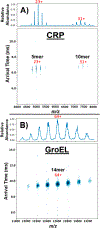Implementing Digital-Waveform Technology for Extended m/ z Range Operation on a Native Dual-Quadrupole FT-IM-Orbitrap Mass Spectrometer
- PMID: 34797072
- PMCID: PMC9026758
- DOI: 10.1021/jasms.1c00245
Implementing Digital-Waveform Technology for Extended m/ z Range Operation on a Native Dual-Quadrupole FT-IM-Orbitrap Mass Spectrometer
Abstract
Here, we describe a digital-waveform dual-quadrupole mass spectrometer that enhances the performance of our drift tube FT-IMS high-resolution Orbitrap mass spectrometer (MS). The dual-quadrupole analyzer enhances the instrument capabilities for studies of large protein and protein complexes. The first quadrupole (q) provides a means for performing low-energy collisional activation of ions to reduce or eliminate noncovalent adducts, viz., salts, buffers, detergents, and/or endogenous ligands. The second quadrupole (Q) is used to mass-select ions of interest for further interrogation by ion mobility spectrometry and/or collision-induced dissociation (CID). Q is operated using digital-waveform technology (DWT) to improve the mass selection compared to that achieved using traditional sinusoidal waveforms at floated DC potentials (>500 V DC). DWT allows for increased precision of the waveform for a fraction of the cost of conventional RF drivers and with readily programmable operation and precision (Hoffman, N. M. . A comparison-based digital-waveform generator for high-resolution duty cycle. Review of Scientific Instruments 2018, 89, 084101).
Keywords: Fourier-transform ion mobility-Orbitrap mass spectrometry; digital-waveform technology; native mass spectrometry; quadrupole mass spectrometry.
Conflict of interest statement
The authors declare the following competing financial interest(s): The power supplies used for this instrument were purchased from G.A.A. Custom Electronics, owned by a co-author (G.A.A.). Other authors declare no competing financial interests.
Figures





Similar articles
-
Fourier Transform-Ion Mobility-Orbitrap Mass Spectrometer: A Next-Generation Instrument for Native Mass Spectrometry.Anal Chem. 2018 Sep 4;90(17):10472-10478. doi: 10.1021/acs.analchem.8b02463. Epub 2018 Aug 22. Anal Chem. 2018. PMID: 30091588 Free PMC article.
-
Experimental Investigation of a Digital Quadrupole Inductively Coupled Plasma Mass Spectrometer for Elemental Analysis.J Am Soc Mass Spectrom. 2024 Aug 7;35(8):1838-1845. doi: 10.1021/jasms.4c00167. Epub 2024 Jul 15. J Am Soc Mass Spectrom. 2024. PMID: 39007349
-
Native IM-Orbitrap MS: Resolving What Was Hidden.Trends Analyt Chem. 2020 Mar;124:115533. doi: 10.1016/j.trac.2019.05.035. Epub 2019 May 31. Trends Analyt Chem. 2020. PMID: 32189816 Free PMC article.
-
Screening of synthetic PDE-5 inhibitors and their analogues as adulterants: analytical techniques and challenges.J Pharm Biomed Anal. 2014 Jan;87:176-90. doi: 10.1016/j.jpba.2013.04.037. Epub 2013 May 6. J Pharm Biomed Anal. 2014. PMID: 23721687 Review.
-
THE IMS PARADOX: A PERSPECTIVE ON STRUCTURAL ION MOBILITY-MASS SPECTROMETRY.Mass Spectrom Rev. 2021 May;40(3):280-305. doi: 10.1002/mas.21642. Epub 2020 Jul 1. Mass Spectrom Rev. 2021. PMID: 32608033 Free PMC article. Review.
Cited by
-
Top-down mass spectrometry of native proteoforms and their complexes: a community study.Nat Methods. 2024 Dec;21(12):2388-2396. doi: 10.1038/s41592-024-02279-6. Epub 2024 May 14. Nat Methods. 2024. PMID: 38744918
-
Instrumentation at the Leading Edge of Proteomics.Anal Chem. 2024 May 21;96(20):7976-8010. doi: 10.1021/acs.analchem.3c04497. Epub 2024 May 13. Anal Chem. 2024. PMID: 38738990 Free PMC article. Review.
-
Optimization of a Digital Mass Filter for the Isolation of Intact Protein Complexes in Stability Zone 1,1.Anal Chem. 2023 Feb 7;95(5):3062-3068. doi: 10.1021/acs.analchem.2c05221. Epub 2023 Jan 26. Anal Chem. 2023. PMID: 36701646 Free PMC article.
-
Modified Ion Source for the Improved Collisional Activation of Protein Complexes.J Am Soc Mass Spectrom. 2023 May 3;34(5):977-980. doi: 10.1021/jasms.3c00071. Epub 2023 Mar 31. J Am Soc Mass Spectrom. 2023. PMID: 37001029 Free PMC article.
-
Adaptation and Operation of a Quadrupole/Time-of-Flight Tandem Mass Spectrometer for High Mass Ion/Ion Reaction Studies.Int J Mass Spectrom. 2022 Aug;478:116874. doi: 10.1016/j.ijms.2022.116874. Epub 2022 May 21. Int J Mass Spectrom. 2022. PMID: 37032994 Free PMC article.
References
-
- Clemmer DE; Russell DH; Williams ER Characterizing the Conformationome: Toward a Structural Understanding of the Proteome. Acc. Chem. Res 2017, 50 (3), 556–560. - PubMed
-
- Bai X-C; McMullan G; Scheres SHW How cryo-EM is revolutionizing structural biology. Trends Biochem. Sci 2015, 40 (1), 49–57. - PubMed
-
- Murata K; Wolf M Cryo-electron microscopy for structural analysis of dynamic biological macromolecules. Biochim. Biophys. Acta, Gen. Subj 2018, 1862 (2), 324–334. - PubMed
-
- Shi Y A Glimpse of Structural Biology through X-Ray Crystallography. Cell 2014, 159 (5), 995–1014. - PubMed
Grants and funding
LinkOut - more resources
Full Text Sources

